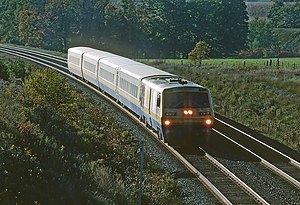LRC (train)

LRC No. 6917 at Newtonville, Ontario.
|
|||||||||||||||||||||||||||||||||||||
|
|||||||||||||||||||||||||||||||||||||
|
|||||||||||||||||||||||||||||||||||||
|
|||||||||||||||||||||||||||||||||||||
|
|||||||||||||||||||||||||||||||||||||
| Type and origin | |
|---|---|
| Power type | Diesel-electric |
| Builder | Bombardier Transportation |
| Order number | M6109, M6125 |
| Serial number | M6109-01 to M6109-21, M6125-01 to M6125-10 |
| Build date | 1980–1984 |
| Total produced | LRC-2: 21, LRC-3: 10 |
| Specifications | |
|---|---|
| AAR wheel arr. | B-B |
| UIC class | Bo′Bo′ |
| Gauge | 4' 8 1/2" standard gauge |
| Length | 63 ft 8 in (19.41 m) |
| Width | 10 ft 5 1⁄2 in (3.19 m) |
| Height | 12 ft 11 in (3.94 m) |
| Loco weight | 250,000–256,000 lb (113–116 t) |
| Fuel type | Diesel fuel |
| Prime mover |
ALCO designed 16-251F Built by MLW / BT in Montreal |
| Engine type | Four-stroke diesel |
| Aspiration | Turbocharged |
| Alternator | GTA-17PF2 (traction), GY-68PA1 (aux), 2 Stamford C534B (HEP) |
| MU working | Yes (2 back to back or push-pull) |
| Train heating | HEP 480 Volt 60 Hertz AC |
| Loco brake | Air |
| Train brakes | Air |
| Couplers | Type H (APTA) |
| Performance figures | |
|---|---|
| Maximum speed | 95 mph (153 km/h) |
| Power output | 3,700–2,700 hp (2.76–2.01 MW) for traction, remainder for locomotive auxiliaries and HEP |
| Career | |
|---|---|
| Operators | Via Rail, Amtrak |
| Numbers | VIA 6900–6920 (LRC-2), 6921–6930 (LRC-3), Amtrak 38-39 |
| Locale | North America |
| Preserved | Via 6917 and Via 6921( both in operating condition) |
| Restored | Via 6917: May 2014 |
| Current owner | Via 6917: Toronto Railway Historical Society |
| Disposition | Most scrapped, two preserved, some for sale |
| LRC-2 and LRC-3 passenger car | |
|---|---|

An LRC passenger car.
|
|
| Manufacturer | Bombardier Transportation |
| Built at |
La Pocatière, Quebec Via Plattsburgh Amtrak |
| Operator(s) | Via Rail, Amtrak |
| Specifications | |
| Car body construction | Aluminum |
| Car length | 85 ft (25.91 m) |
| Width | 10 ft 5 1⁄2 in (3.19 m) |
| Height | 12 ft 11 in (3.94 m) |
| Floor height | 51 in (1,295 mm) |
| Power supply | HEP 480 Volt |
| Braking system(s) | Air |
| Coupling system | Tightlock coupling, APTA Type H |
| Track gauge | 1,435 mm (4 ft 8 1⁄2 in) standard gauge |
The LRC (a bilingual acronym: in English: Light, Rapid, Comfortable; in French: Léger, Rapide, et Confortable) is a series of lightweight diesel-powered passenger trains that were used on short- to medium-distance inter-city service in the Canadian Provinces of Ontario and Quebec. It originally consisted of both locomotives and passenger carriages designed to work together, though the two can be (and now are) used separately.
LRC was designed to run with locomotives, or power cars, at both ends and provide 125 mph (201 km/h) service on non-upgraded railway routes. To accomplish this, the LRC passenger cars feature active-tilt technology to reduce the forces on the passengers when a train travels at high speeds around a curve in the railway tracks. LRCs have reached speeds as high as 130 mph (210 km/h) on test runs.
On its only regular service route, on the Quebec City – Windsor Corridor, wear concerns, signalling issues and conflicts with slower moving freight trains limit this to 100 mph (160 km/h) or less. For service at these speeds, a single power car was used. Special signage allowed the LRC to run at higher speeds than normal traffic across a great portion of the Corridor when the tilt system was enabled.
Although the last LRC locomotive was removed from service on 12 December 2001, the passenger cars are still in widespread use and form the backbone of Via Rail's services, albeit with the tilt system disabled. The same basic car forms the basis of the Acela Express in the U.S.
As a vehicle turns it generates centrifugal force, which is proportional to the square of the speed and inversely proportional to the radius. Even a small amount of force, acting across the length of the human body, creates a moment that can make moving about difficult. Centrifugal forces are not normally an issue in an automobile because the occupants are seated, nor in an aircraft where the fuselage is tilted so the centrifugal force passes through the line of the floor. It is primarily a problem in high-speed trains, where passengers and attendants often walk about while the train is moving. The force also pushes the entire train sideways, leading to wear of the outer rail. This was not an issue on early railways where the speed was low, but gained importance as line speeds increased and the radius of curvature became tighter.
...
Wikipedia
